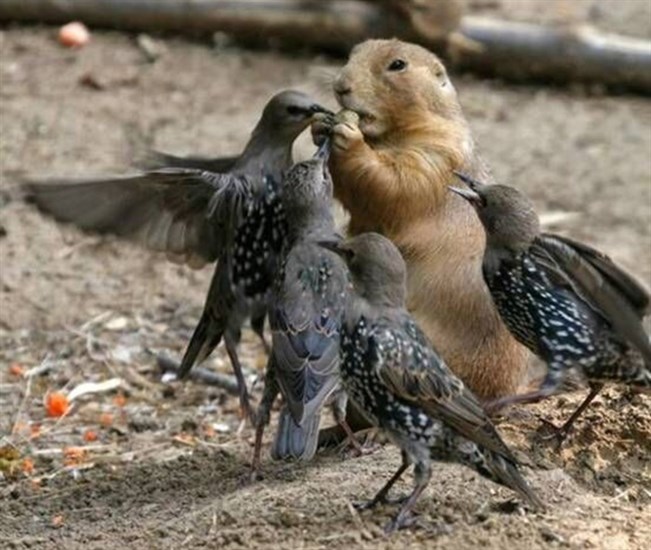
Starlings harass a groundhog for food. An Okanagan agricultural program has taken a big bite out of invasive starling populations since it began in 2003, receiving praise from growers, who are able to retain more of the crop during harvest.
Image Credit: SUBMITTED/B.C. Grape Growers' Association
October 11, 2017 - 3:18 PM
OKANAGAN - The success of a program to control the starling population is more apparent with each passing grape harvest as growers have less work in the vineyard, and everyone else enjoys the sounds of silence with fewer propane cannons blasting away.
The Starling Control Program, run by the B.C. Grape Growers' Association, is credited with reducing the population of the invasive species by 746,000 birds from its inception in 2003 until last year.
Administrative officer Tyrion Miskell says four trappers work up and down the valley from the North Okanagan to Osoyoos, capturing starlings in traps placed in strategic locations. The program, which Miskell admits is “fairly expensive to run,” is funded through the valley’s three regional districts, who contribute $25,000 each, on an annual basis, along with contributions from grape and fruit growers.
Naramata grape grower Rod King is a big fan of the starling control program.
"The annual levy I pay on a per acre basis is the best money I've spent in years," he says. "At this time of year it used to be an almost full time job monitoring the vineyards for birds, with the need for additional equipment such as nets, propane cannons and firearms."
King says he doesn't need to place nets around the vines anymore, which is a considerable savings in time and money.
"We don't even think of the birds anymore. I believe it's directly attributable to the program," he says.

A typical starling trap is pictured in this submitted photo.
Image Credit: SUBMITTED/B.C. Grape Growers' Association
He calls it a win-win for both growers and residents who don't have to put up with the noise from propane cannons in the vineyards.
"With the reduction in starling populations the songbirds aren't being out-competed for their territory and we're starting to see more of them now as well," King says.
Miskell says the starling control program is made up of three parts: Trapping the birds, public education and research.
“Our research has proven the program is effective, and doing what it’s supposed to be doing,” she says.
Miskell says the research has shown winter populations of starlings in the Okanagan are increasing because they are no longer migrating for the winter.
"We used to think that populations wintered somewhere else and came to the Okanagan for the summer to nest and to take advantage of the endless fruit sources, leaving again for more temperate climates in the winter," she says.
It turns out the birds like the urban and semi-urban mix in the valley and are staying for the winter. A University of B.C. study shows 60 to 70 per cent of the birds are locally born and stay all year long.
“We thought they would winter on the coast and return in the summer, but that’s not what they are doing. They’re probably moving north to south rather than east to west,” she says.
Trappers are also noticing a decline in bird populations, particularly this year.
“It may be just a blip, due to the cold, wet spring we had but trappers are seeing half the birds they counted last year. Bird counts are way down,” Miskell says
It's a trend they plan to keep an eye on in the coming years.
Starlings were first documented in the Okanagan in 1945. It’s believed they became an established species in the valley sometime between 1952 and 1956.
Conservative estimates are that the starlings cost growers $4 million a year in crop damage in the Okanagan.
To contact a reporter for this story, email Steve Arstad or call 250-488-3065 or email the editor. You can also submit photos, videos or news tips to the newsroom and be entered to win a monthly prize draw.
We welcome your comments and opinions on our stories but play nice. We won't censor or delete comments unless they contain off-topic statements or links, unnecessary vulgarity, false facts, spam or obviously fake profiles. If you have any concerns about what you see in comments, email the editor in the link above.
News from © iNFOnews, 2017